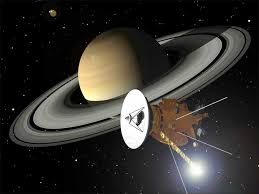Spacecraft diving deep into Saturn moon’s erupting water jet
CAPE CANAVERAL, Fla. (AP) — The Cassini spacecraft is about to get an icy shower as it orbits Saturn.
On Wednesday, Cassini will storm through a jet of water vapor and frozen particles erupting from the south pole of Enceladus, one of Saturn’s many moons. The spacecraft will zoom within 30 miles of the pole, providing the best sampling yet of its underground ocean.
Cassini will be traveling 19,000 mph, so it should take just an instant to penetrate the plume.
A global liquid ocean is believed to exist beneath the frozen crust of 300-mile-wide Enceladus. Wednesday’s dive will be the deepest one yet through the continuous plumes, making the enterprise a bit riskier than usual.
Launched in 1997, Cassini is not equipped to detect life, but scientists hope Wednesday’s flyby will provide clues as to the possibility of it.
NASA program scientist Curt Niebur considers Wednesday’s feat “a very big step in a new era of exploring ocean worlds in our solar system.”
Other probable extraterrestrial ocean worlds: Saturn’s largest moon, Titan; Jupiter’s moons, Europa, Ganymede and Callisto; and possibly dwarf planets Pluto and Ceres, among others.
“These are worlds with huge bodies of liquid water underneath their surfaces, bodies with great potential to provide oases for life throughout our solar system,” Niebur said Monday. “It’s a journey in understanding about what makes a world habitable and where we might find life, and where we might one day live ourselves.”
Researchers are eager to nail down the chemical makeup of Enceladus’ plumes. They also hope to confirm whether the eruptions are tight columns or curtains of jets running along fractures in the south pole.
In particular, the spacecraft will be looking to identify hydrogen molecules in the plume, which would help quantify hydrothermal activity occurring on the ocean floor. That, in turn, would help characterize the potential for life in this slightly salty ocean.
If life exists — and more missions would be needed for confirmation — it might range from microscopic algae to little fish, the scientists said.
The action unfolds late Wednesday morning Eastern Time; it will take several hours to confirm success and start returning the information.
Spilker expects it will take a week to get a quick look at the scientific data and many more weeks for a proper analysis.
Close-up pictures of Enceladus should be ready much sooner. Cassini will snap pictures of Enceladus before, during and after the close encounter. The images will be smeared because of Cassini’s speed, but the team hopes to remove the blurs and have some dramatic shots by Thursday night or Friday. Saturnshine — akin to our moonshine — will provide the only lighting for the cameras.
This will be the 21st flyby of Enceladus by Cassini. “It’s not our last, but arguably this one is going to be our most dramatic,” said project manager Earl Maize.
Cassini has come closer to Enceladus — skimming 15½ miles above the surface in 2008 — but never dipped so low through a plume.
Scientists were tempted to fly even lower Wednesday, but did not want to waste fuel. Cassini’s orbit around Saturn will not be disturbed by the plume penetration, they asserted. The U.S.-European spacecraft has two years of life remaining before it plunges into Saturn’s atmosphere and vaporizes.
[livemarket market_name="KONK Life LiveMarket" limit=3 category=“” show_signup=0 show_more=0]


No Comment